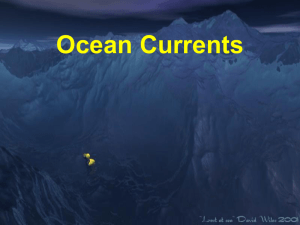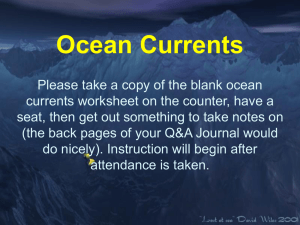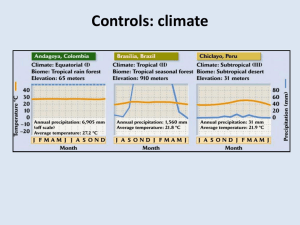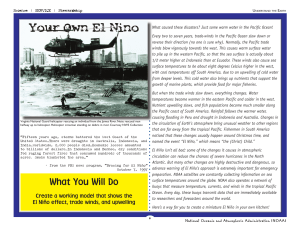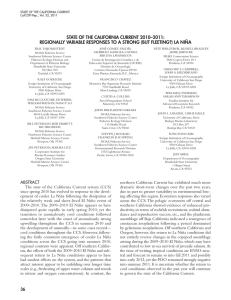Chapter 11, Part 2 Major Ocean Currents January Wind and Pressure 1
advertisement
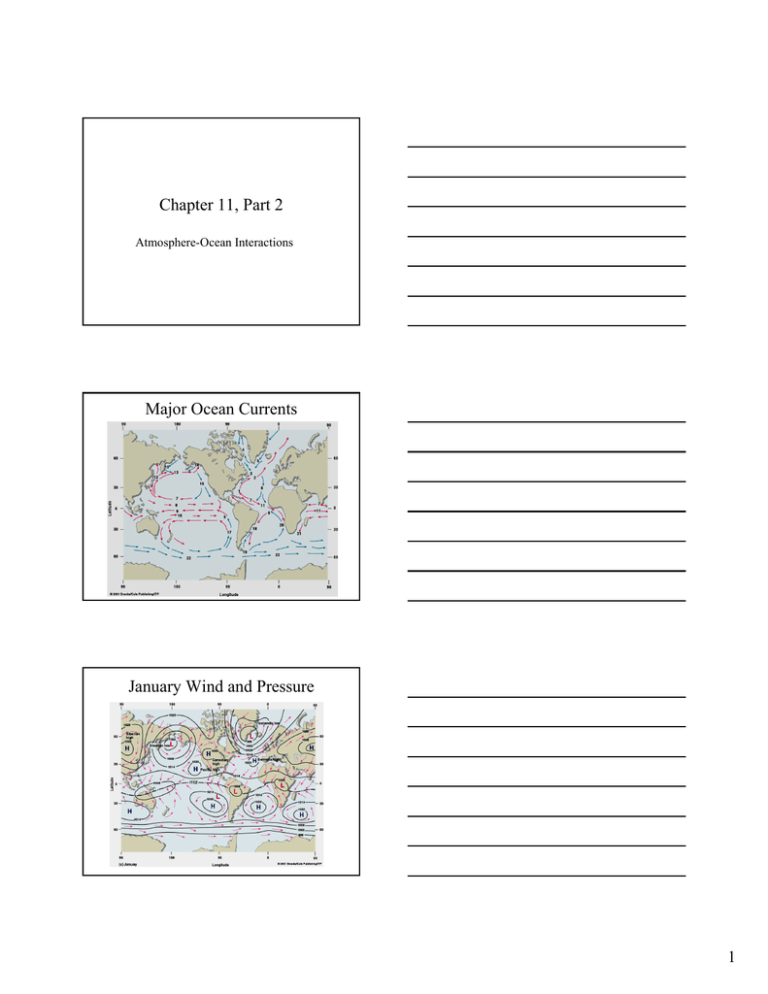
Chapter 11, Part 2 Atmosphere-Ocean Interactions Major Ocean Currents January Wind and Pressure 1 Comparison Wind & Ocean Currents Comparison Wind & Ocean Currents Influence of Wind on Ocean Currents • Wind blowing over the oceans causes the surface water to drift along with it. • Ocean currents do not follow the wind pattern exactly. They flow in semiclosed circular whirls called gyres. 2 Ocean Currents and Heat Transfer • About 40% of the total heat transport in the Northern Hemisphere comes from surface ocean currents. Average Surface Water Temperature on the West Coast • The cool California Current flows south along the west coast. • The water should warm as we go south. • Why then are the coldest surface water temperatures at Cape Mendocino? Ekman Spiral • Due to the Coriolis force, the surface water moves to the right of the wind. • Layers further underneath the surface move to the right of the layers above, until eventually the layers at some depth (~100m) are moving opposite to the surface current. 3 Upwelling • Because the surface current on the west coast is directed out to sea, this causes an upwelling of cold water from below the surface. • The upwelling is strongest at Cape Mendocino because the wind parallels the coast. El Niño • A similar upwelling usually occurs on the west coast of S. America, bring nutrient rich cold water to the surface. • Near the end of the year (Dec/Jan) warm water moves south, stopping upwelling. • Called El Niño (Spanish for boy child). Major El Niño Event • At irregular intervals of 2 to 7 years, the warming covers a large area of the Pacific Ocean. • Fish and birds die because of the loss of nutrients. • Weather around the world is disrupted with some areas receiving more rain than normal and others less. 4 Non-El Niño Conditions • Normally, trade winds blow toward the west (H to L). • Surface water near the equator is cool in the east and warm in the west. • The wind raises slightly the water in the western Pacific, producing a weak countercurrent. El-Niño Conditions • Air pressure rises over the western Pacific and falls over the eastern Pacific, weakening the trade winds and strenghtening countercurrent. • Surface water warms over western Pacific and heads eastwards (Kelvin wave – only 15cm high). Kelvin Wave • Kelvin wave moving eastward in March/April 1997. • White areas are 20cm (8 in.) higher than average. • Red areas are 10cm (4 in.) higher than average. 5 Non-El Niño Water Temperature • Water is cooler in the east and warmer in the west. El Niño Water Temperatures • Water is warmer in the east and cooler in the west. Southern Oscillations • El Niño conditions occur at irregular intervals. • When the pressure rises in the east (opposite of El Niño), the phenomena is called El Niña (the girl child). • Entire cycle is called Southern Oscillation. 6 Global Effects of El Niño • Droughts in Indonesia, southern Africa, and Australia. • Heavy rains and flooding in Ecuador and Peru. • Storms in California and heavy rain in Gulf Coast States. • A strong El Niña also effects weather globally. Regions Effected by Strong ENSO Warm Dry Wet Winter Weather Patterns over North America El Niño La Niña 7 Summary • Ocean currents flow in semiclosed circular whirls and roughly follow the wind direction. • Wind blowing parallel to the coast can lead to upwelling of cold water from below. • In an El Niño event water in the eastern Pacific warms and water in the western Pacific cools. 8


